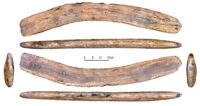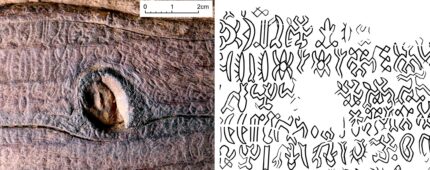 A 3D model of a wooden tablet from Easter Island has revealed engravings in the rongorongo writing system invisible to the naked eye. A new study of a tablet now in the collection of the Berlin Ethnographic Museum, employed photogrammetry to create a high-precision digital reconstruction of the wood surface
A 3D model of a wooden tablet from Easter Island has revealed engravings in the rongorongo writing system invisible to the naked eye. A new study of a tablet now in the collection of the Berlin Ethnographic Museum, employed photogrammetry to create a high-precision digital reconstruction of the wood surface
Researchers estimated that there are about 600 characters of rongorongo. Among them there are representations resembling human figures, characterized by supernaturally long arms, shown in various arrangements, as well as animals: birds, fish, sharks and rats. No other Polynesian peoples invented the script. Scientists are now making efforts to read the mysterious writing. Despite many question marks, researchers of the mysterious writing have established a few facts. First of all, it is known that it was used by the aristocracy living on the island – so it was not a commonly used script. Sentences were read in the inverted boustrophedon system – the object had to be rotated while reading.
Because the island of Rapa Nui is so remote its culture developed in total isolation from the Polynesian settlement in the 12th or 13th century until the arrival of Dutch explorer Jacob Roggeveen in 1722. The first westerner to encountered rongorongo was French missionary Eugène Eyraud who saw the symbols in islanders’ homes on his first mission to Rapa Nui in 1864. By then the system had rapidly fallen into disuse, believed to be a result of its writing elite being captured and enslaved in the Peruvian raids of the early 1860s. In a December 1864 letter to the Father Superior of his order in Paris, Eyraud wrote:
In all the homes there were wooden tablets covered with many types of hieroglyphic characters, which are symbols of animals that do not exist on the island and which the natives incise with a sharp stone. Each symbol has a name but the minimal fuss that the natives make of these tablets leads me to believe that these symbols, the remains of a primitive writing system, represent a custom that they continue to practice without trying to recall its meaning.
A piece of an engraved tablet was gifted to Bishop Tepano Jaussen of Tahiti in 1869, and he encouraged the collection of all other tablets with inscriptions still surviving on Rapa Nui. Ravaged by slave raids, deforestation, the invasive Polynesian rat and massive emigration, the population of the island collapsed in the 1870s.
Today only 23 rongorongo-engraved artifacts are known to exist, none of them on Rapa Nui. Rongorongo’s origins are unknown and the glyphs are as yet undeciphered, but if it is confirmed to be a writing system, it will be one of very few examples of an independently invented script in human history.
The Berlin Tablet was made from a large curved tree branch with the sides carved out to form flattened surfaces for incision. It is 3’4″ long and weighs 5.7 lbs, making it the heaviest rongorongo artifact surviving. It was one of three belonging to Chief Hangeto that were sold to Germany in 1882. It is in a poor state of preservation, heavily damaged on one side that is believed to have been facing the soil of a cave floor for years before it was collected. Woodlice, centipedes and woodworms also made a tasty meal of it.
The new study took tiny samples from the damaged side of the tablet for botanical identification and radiocarbon dating. The wood was identified as T. hespesia populnea, the Pacific rosewood which was one of the only naturally occurring tree species on Easter Island. Radiocarbon dating found that it was made between 1830 and 1870.
“On the other side of the tablet and on its edges, we managed to see invisible to the naked eye symbols that have so far eluded researchers, as well as grooves – similar ones are present on some other rongorongo tablets. They served as lines delimiting the text and were to facilitate writing”- specified [Dr Rafał Wieczorek]. On this basis, the researchers were able to estimate the size of the entire text on the plate at approx. symbols.
“If the tablet had been preserved in its entirety, it would have been the longest Rongorongo script in the world. Currently, most signs are on the so-called the staff of Santiago. There are about 2.3 thousand of them there.” the scientist pointed out. The Berlin plate – according to the Polish researcher – probably contains a list of names and a descriptive part.
Only 387 glyphs are legible half of one side of the tablet today, but researchers estimated based on the geometry of the tablet that it originally covered with over 5000 signs, which is more than double the number of the next longest rongorongo inscription.
The new study has been published in the Journal of Island and Coastal Archeology and can be read in its entirety here.

Interesting censorship, something knotty must have been engraved there.. 😎
The wood came from a Thespesia populnea. Apparently it is native to India but is now pantropical. It is considered invasive in Florida by the Florida Exotic Pest Plant Council.
Looks more like an early boomerang.
check out this site. that may account for the animals on it.
https://australian.museum/learn/cultures/atsi-collection/boomerangs/